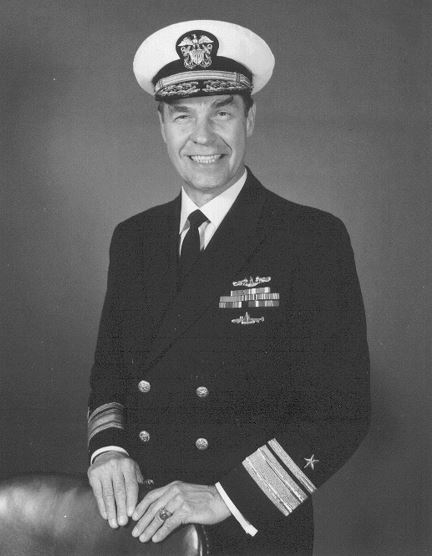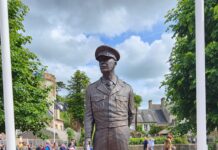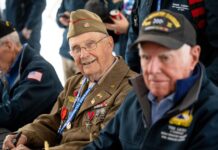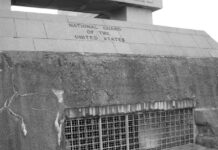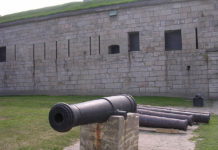One of the U.S. Navy’s submarine leaders has been the driving force behind the Nimitz Foundation and National Museum of the Pacific War, retired Rear Adm. Charles Grojean, served as executive director of the Nimitz Foundation. The Foundation provides private financial support to expand and enhance the collections, exhibits, and programs of the National Museum of the Pacific War located in Fredericksburg, Texas. It also works to further research and document the historical record of the Pacific War.
We spoke with Adm. Grojean before his death in 2008 about the mission of the foundation and museum. Grojean attended the Virginia Military Institute for a year before accepting an appointment to the U.S. Naval Academy. After graduation from the Academy in 1945, he served four ears in the black shoe Navy before reporting to New London in November 1949 to begin training for his new career in the “silent service.”
After earning his dolphins, Grojean served in both diesel/electric and nuclear submarines in the Atlantic and Pacific fleets. He later commanded Angler, Barb and Thomas Edison, as well as Submarine Flotilla Eight and Submarine Force Mediterranean (Naples), Italy.
Grojean, known as Chuck to his friends, entered the submarine service at that critical time when the nuclear submarine became a primary means by which the U.S. Navy projected American power on the high seas. Under the driving tutelage of the controversial Adm. Hyman G. Rickover, the U.S. Navy’s and the world’s first nuclear powered boat, USS Nautilus, slid down the ways in January 1954. It was quickly followed by a succession of nuclear boats, both hunter/killer/attack types designed to track Soviet submarines by utilizing our sophisticated electronic capability coupled with our knowledge of undersea thermal layers and the “boomers,” boats deploying our Polaris ICBMs. The new undersea nuclear Navy in which Grojean served with such distinction had become a vital part of America’s defense strategy during the Cold War with the Soviet Union.
Grojean’s later shore assignments included duty at the Naval Academy, service on the staffs of the Secretary of Defense, the Joint Chiefs of Staff and the Chief of Naval Operations, where he was director of political affairs.
Interviewer: What is your involvement with the Nimitz Foundation?
Grojean: I retired from active duty in June 1975. At that time, I was offered the position of superintendent of the Iranian Naval Academy, which was going to be located on the Caspian Sea. That fell through, so I moved to San Antonio and became a venture capitalist. Although that was a profitable venture with great people, I decided to become executive director of the Nimitz Foundation in July of 1990. It was a pro bono position, because at the time, the Foundation had no money. We have since come a long way. Our annual budget is now in the neighborhood of a $500,000 a year. In addition, we have raised more than $6 million since 1994 to enlarge the museum and build The National Museum of the Pacific War. We have become quite an active group since our beginning. We are currently conducting a campaign to raise $12 million dollars.
Interviewer: That money will go toward a new facility?
Grojean: Approximately $9 million will go toward a new facility. We are hoping that the state of Texas will help. We are also hoping to raise $3 million from the private sector to go toward an endowment to assist with the operation of the museum.
Interviewer: How has the museum evolved over the years?
Grojean: There was a group of people in Fredricksburg who decided they would buy the old Nimitz Hotel, which had been owned by the grandfather of Adm. Nimitz. Their idea was to buy the hotel and create a museum named for Adm. Nimitz. When the group approached the admiral with the idea, he agreed that his name could go on the museum. But he requested that hotel building be restored to the condition it was when his grandfather owned it. In addition, he wanted the museum dedicated to all of the men and women who had served with him in the Pacific. So that building, which looks like a steamboat, was home for the museum. In 1994, we decided to go out and raise the money to build a larger facility that would better house our growing collection.
Interviewer: What are highlights of your collection?
Grojean: We have the best collection of Pacific war artifacts in the world. We even have the 80-foot, two-man Japanese submarine captured at Pearl Harbor. I have spoken with the pilot of the sub, Mr. Sakamaki, who became prisoner of war No. 1 after he was captured. Mr. Sakamaki returned to the United States in 1991 for the 50th anniversary of the attack on Pearl Harbor. He was concerned that someone may want to harm him if he came back, but I assured him that he would be safe, that we had put the war behind us and we were just looking for history. We had a terrific memorial symposium—more than 1,000 attended, including former President George Bush.
Interviewer: I noticed that you have an area specifically dedicated to President H.W. Bush’s service.
Grojean: Yes, the main museum, which is the George Bush Gallery, is one we plan to expand by another 40,000 square feet. In there, we have the casing for what would have been the No. 3 or No. 4 atomic bomb dropped on Japan. In addition we have an area called the Pacific Combat Zone. We have five huge buildings. One building has a replica of the type of plane that President Bush flew on an aircraft carrier hanger deck. In the next building, we have a PT boat base–like those in the South Pacific in 1942. When you go through the buildings on a guided tour, there are mannequins on the exhibits that “talk” and so forth. We also have a World War II Quonset hut, where we have a medical exhibit. It is very moving, a lot of people come out of there in tears.
Interviewer: How did you acquire these pieces?
Grojean: A lot of the things like tanks and guns, the son of my predecessor here, Doug Hubbard, went over to New Guinea, New Britain and other places to get them back here. Many of them are actual pieces that were used in service–picked up right off the battlefields. Some are rusty. A lot of this work was done in the 1960s.
Interviewer: How many visitors does the museum have each year?
Grojean: Depending on the year, from 85,000 to 105,000.
Interviewer: What is the admission fee?
Grojean: The fee is now $5 for adults. Children are $3, but we can make special arrangements for school classes. We have 15,000 students come through each year.
Interviewer: You served for many years in the U.S. Navy, what are some of your best memories?
Grojean: I served for 30 years. I think the highlight was when I commanded a submarine force in the Mediterranean–my home base was Naples, Italy. Professionally, it was very rewarding. It was right in the middle of the Cold War. My subs and the Russian subs were always following each other, keeping track of what each of us was doing. I was there from 1968 to 1971.
Interviewer: What was your reason for choosing the submarine service?
Grojean: You got a command early, it’s a smaller outfit and there is a lot of camaraderie. It was very exciting. I went into submarines before I was aware of the nuclear power aspect of it. Nuclear power was the best thing that happened to us. I had command of a diesel sub, then a nuclear attack sub, and then I went to a nuclear missile sub.
Interviewer: What was the name of the first nuclear boat you commanded?
Grojean: That was the Barb, named after the famous World War II submarine Barb, which was in the top three of sinking enemy tonnage.
Interviewer: I am sure that you had many exciting experiences. Does anything specifically come to mind about your service?
Grojean: There were always near misses, every time you read of a collision, a submerged collision, you think, “there but for the grace of God goes I.” There were many times things went wrong–tension was very high. You always figure that you’ll get out of it, and we always did, but the Thresher didn’t get out of hers, and the Scorpion didn’t get out of hers; they both sank. The Thresher on a sea trial and the Scorpion en route back to its home port in Norfolk–it just never arrived. We put out a search team. But after several weeks of searching, we found the ship on the bottom of the ocean. It had imploded.
Interviewer: Did you know Admiral Rickover?
Grojean: Oh yes, very well. I served with him on his staff for a whole year and trained for nuclear—and I saw him every day. He was a very unique, dynamic, controversial individual. Every nuclear officer that went into the submarine force from the 1950s to the 1980s had to be approved by him. He was the tsar of the submarine service. Unfortunately, his tactics drove a wedge between the submarine force at the time. Some guys who were not accepted were resentful, but they usually got over it.
Interviewer: Concerning the Pearl Harbor controversy, have you read “Scapegoats,” which defended Admiral Kimmel and General Short?
Grojean: I have not read it, but I have a file about two-feet-thick on the whole thing.
Interviewer: I suppose you have more information on it than the average Joe….
Grojean: In fact, Kimmel’s son was my squadron commander when I commanded my first diesel submarine in Groton, Conn.
Interviewer: Was he highly thought of?
Grojean: Very highly. All of the Kimmels were well thought of.
Interviewer: What were you doing when you heard of the attack on Pearl Harbor?
Grojean: I was on my way back from church at Virginia Military Institute, passing Robert E. Lee’s tomb, and another student told me about the attack. I thought it was bum dope–it was impossible for any battleship to ever be sunk.
Interviewer: Any other thoughts why someone should visit the museum?
Grojean: Your readers should know that the museum is now very large and everybody who goes through thinks it’s great. We are only 73 miles from San Antonio. The drive from there is beautiful–right through the Texas Hill country!
Museum website: pacificwarmuseum.org



